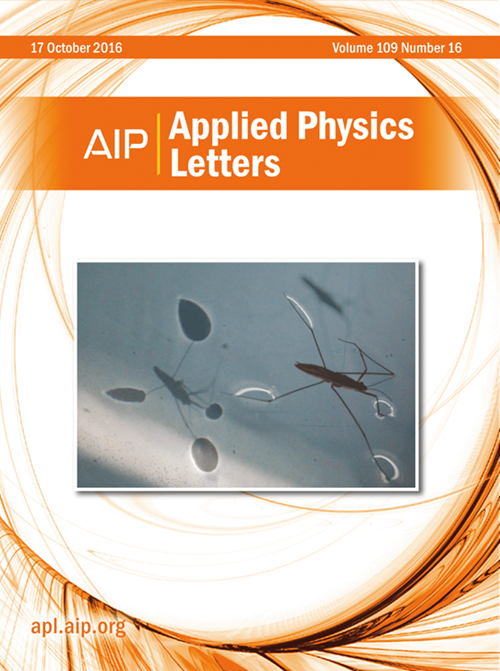IF 3.5
2区 物理与天体物理
Q2 PHYSICS, APPLIED
引用次数: 0
摘要
各向异性对于理解和优化具有方向依赖性的材料特性起着至关重要的作用。化合物半导体中的典型晶体结构--六方钨锆石结构表现出明显的各向异性,尤其是在对外部刺激的反应方面。最近,光照下的力学行为引起了越来越多的关注,尤其是在半导体化合物中。在这项研究中,我们研究了光照效应对晶圆氧化锌纳米力学性能的各向异性。在受控光照下,对四种表面取向--(0001)、(0001) 45° off、(11¯00)和(21¯1¯0)--进行了纳米压痕蠕变和纳米压痕硬度测试。在所有表面方向上,光照下纳米压痕蠕变过程中的压痕深度始终小于黑暗条件下的压痕深度,这证实了光抑制压痕蠕变变形,但程度因表面方向不同而不同。这表明在光照下,激活的滑移系统和位错的分布在调节位错行为方面起着至关重要的作用。纳米压痕硬度随四个表面取向的变化趋势而变化:(0001)> (0001) 45° off >(11¯00)> (21¯1¯0),反映了纳米力学性能的各向异性。我们还提取了第二次和随后的弹入事件,它们因表面取向的不同而表现出不同的行为,可能在决定纳米压痕硬度的各向异性方面起着关键作用。我们的研究结果有助于全面了解晶格氧化锌在光控制下的塑性各向异性。本文章由计算机程序翻译,如有差异,请以英文原文为准。
Photoplastic anisotropy in nanoindentation of wurtzite ZnO single crystals
Anisotropy plays a crucial role in understanding and optimizing the properties of materials with directional dependencies. The hexagonal wurtzite structure, which is a typical crystal structure in compound semiconductors, demonstrates pronounced anisotropy, especially in its response to external stimuli. Recently, mechanical behavior under light illumination has attracted increasing interest especially in semiconductor compounds. In this study, we investigated the anisotropy of illumination effects on the nanomechanical properties of wurtzite ZnO. Four surface orientations—(0001), (0001) 45° off, (11¯00), and (21¯1¯0)—were subjected to nanoindentation creep and nanoindentation hardness tests under controlled light illumination. The indentation depth during nanoindentation creep under light illumination was consistently smaller than that in darkness for all surface orientations, confirming that light suppresses indentation creep deformation, but to different degrees depending on the surface orientation. This suggests that the activated slip systems and the distribution of dislocations play a crucial role in modulating dislocation behavior under light illumination. The nanoindentation hardness followed the trend on the four surface orientations: (0001) > (0001) 45° off > (11¯00) > (21¯1¯0), reflecting anisotropic behavior in nanomechanical properties. Second and subsequent pop-in events were extracted, exhibiting different behaviors depending on the surface orientations, and may play a key role in determining the anisotropy in nanoindentation hardness. Our findings contribute to a comprehensive understanding of the plastic anisotropy under light control in wurtzite ZnO.
求助全文
通过发布文献求助,成功后即可免费获取论文全文。
去求助
来源期刊

Applied Physics Letters
物理-物理:应用
CiteScore
6.40
自引率
10.00%
发文量
1821
审稿时长
1.6 months
期刊介绍:
Applied Physics Letters (APL) features concise, up-to-date reports on significant new findings in applied physics. Emphasizing rapid dissemination of key data and new physical insights, APL offers prompt publication of new experimental and theoretical papers reporting applications of physics phenomena to all branches of science, engineering, and modern technology.
In addition to regular articles, the journal also publishes invited Fast Track, Perspectives, and in-depth Editorials which report on cutting-edge areas in applied physics.
APL Perspectives are forward-looking invited letters which highlight recent developments or discoveries. Emphasis is placed on very recent developments, potentially disruptive technologies, open questions and possible solutions. They also include a mini-roadmap detailing where the community should direct efforts in order for the phenomena to be viable for application and the challenges associated with meeting that performance threshold. Perspectives are characterized by personal viewpoints and opinions of recognized experts in the field.
Fast Track articles are invited original research articles that report results that are particularly novel and important or provide a significant advancement in an emerging field. Because of the urgency and scientific importance of the work, the peer review process is accelerated. If, during the review process, it becomes apparent that the paper does not meet the Fast Track criterion, it is returned to a normal track.
 求助内容:
求助内容: 应助结果提醒方式:
应助结果提醒方式:


